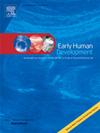Validity of the DF-MOT to detect motor developmental delays in preterm children: A comparative study with the Bayley-III
IF 2
3区 医学
Q2 OBSTETRICS & GYNECOLOGY
引用次数: 0
Abstract
Background
The Motor Functional Development Scale for Young Children (DF-MOT) is a motor developmental scale originally designed and standardized for full-term children.
Aim
To validate the DF-MOT for diagnosing motor delays in preterm children, using the Bayley Scales of Infant and Toddler Development, Third Edition (Bayley-III), as a reference.
Study design
Prospective concurrent validity study.
Method
Seventy-six preterm children born before 32 weeks' gestational age were concurrently assessed at corrected ages of 9 to 30 months using the DF-MOT and the Bayley-III. Validation of the DF-MOT involved a three-step process: (1) raw and standardized scores correlation analysis, (2) receiver-operating characteristic (ROC) curve analysis to assess diagnostic accuracy, and (3) diagnostic properties analysis for the primary DF-MOT cut-offs.
Results
Correlation analysis demonstrated very strong correlation for both gross and fine motor raw scores (r = 0.95 and 0.94, respectively), and strong to weak correlation for the standardized scores (ρ = 0.66 and 0.28, respectively). The DF-MOT gross motor subscale (DF-MOT/PML) exhibited excellent diagnostic accuracy on the ROC curve analysis and good diagnostic properties at −1 standard deviation, while the fine motor subscale (DF-MOT/EHGC) appeared to be less accurate in diagnosing delay with the Bayley-III. This disparity in fine motor evaluation seems to be linked to the DF-MOT/EHGC's greater sensitivity to identify fine motor delays.
Conclusion
The DF-MOT is a valid developmental tool for assessing motor skills in preterm children, offering enhanced sensitivity in detecting fine motor delays. It may provide practitioners with in-depth, development-focused assessments.
DF-MOT检测早产儿运动发育迟缓的有效性:与Bayley-III的比较研究
幼儿运动功能发展量表(DF-MOT)是一份专为足月儿童设计并标准化的运动发展量表。目的参照《Bayley婴幼儿发育量表第三版》(Bayley- iii),验证DF-MOT对早产儿运动迟缓的诊断价值。研究设计前瞻性并行效度研究。方法采用DF-MOT和Bayley-III对76例32周前出生的早产儿在9 ~ 30月龄时同时进行评估。DF-MOT的验证包括三个步骤:(1)原始和标准化评分相关性分析,(2)受试者工作特征(ROC)曲线分析以评估诊断准确性,(3)主要DF-MOT截止值的诊断特性分析。结果相关分析显示,粗大运动和精细运动的原始分数具有很强的相关性(r分别为0.95和0.94),标准化分数具有很强的相关性(ρ分别为0.66和0.28)。DF-MOT大运动量表(DF-MOT/PML)在ROC曲线分析上表现出良好的诊断准确性,在- 1标准差下具有良好的诊断性能,而精细运动量表(DF-MOT/EHGC)在Bayley-III诊断延迟方面表现出较低的准确性。精细运动评估的这种差异似乎与DF-MOT/EHGC在识别精细运动延迟方面的更高灵敏度有关。结论DF-MOT是一种有效的评估早产儿运动技能的发展工具,在检测精细运动迟缓方面具有更高的灵敏度。它可以为实践者提供深入的、以发展为重点的评估。
本文章由计算机程序翻译,如有差异,请以英文原文为准。
求助全文
约1分钟内获得全文
求助全文
来源期刊

Early human development
医学-妇产科学
CiteScore
4.40
自引率
4.00%
发文量
100
审稿时长
46 days
期刊介绍:
Established as an authoritative, highly cited voice on early human development, Early Human Development provides a unique opportunity for researchers and clinicians to bridge the communication gap between disciplines. Creating a forum for the productive exchange of ideas concerning early human growth and development, the journal publishes original research and clinical papers with particular emphasis on the continuum between fetal life and the perinatal period; aspects of postnatal growth influenced by early events; and the safeguarding of the quality of human survival.
The first comprehensive and interdisciplinary journal in this area of growing importance, Early Human Development offers pertinent contributions to the following subject areas:
Fetology; perinatology; pediatrics; growth and development; obstetrics; reproduction and fertility; epidemiology; behavioural sciences; nutrition and metabolism; teratology; neurology; brain biology; developmental psychology and screening.
 求助内容:
求助内容: 应助结果提醒方式:
应助结果提醒方式:


